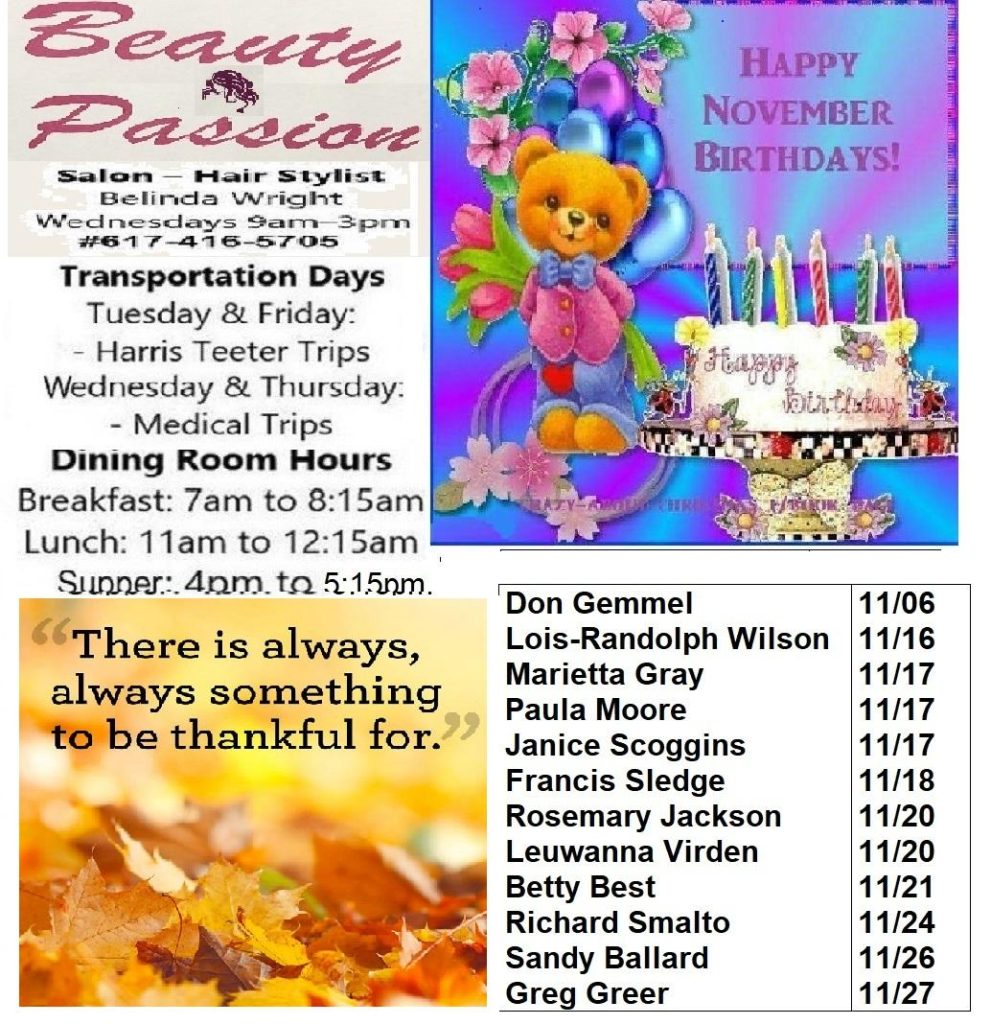THE VILLAGE TIMES
Independence Village of Olde Raleigh Resident Newsletter


Meet Martha (“Mimi”) Flynn
– by Pat Simpson
Let’s take a trip in our Wayback machine, you know, 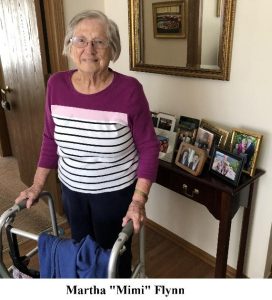 the one they used to have in the State Fair. We’ll go to another place, another time that you may not have thought of lately – if ever. Let’s travel to the peaceful days of yore, when morals were clear, small towns were friendly and quiet, and your neighbor always had a smile on their face.
the one they used to have in the State Fair. We’ll go to another place, another time that you may not have thought of lately – if ever. Let’s travel to the peaceful days of yore, when morals were clear, small towns were friendly and quiet, and your neighbor always had a smile on their face.
I’m thinking of the little town of Wadesboro, North Carolina, where doors were left unlocked, neighbors helped each other out, and the cops were basically just part of the scenery.
The town of Wadesboro lies southeast of Charlotte halfway between Aberdeen and Monroe. It dates back to 1783 when it was founded by Capt. Patrick Boggan and Col. Thomas Wade, famous Revolutionary patriots. The town was first called New Town, later changed to Wadesborough and finally, Wadesboro.
In the early days of the town, taverns flourished and stagecoach travelers stopped to pass the night at places like Buck’s Tavern in uptown Wadesboro. On Sept 26, 1787 Andrew Jackson spent the night at Buck’s Tavern in order to obtain a license to practice law.
Through the mid 1900’s, Wadesboro was a hub for citizens of the county and was a bustling town with crowds of people walking the downtown streets. Traveling into town from the surrounding countryside, people would take in a double feature at the Ansonia Theatre, get a haircut, have lunch at the tea room, have a milkshake at the Parson’s Drug soda fountain, and patronize the dry goods and hardware stores of local merchants.
Wadesboro was a thriving textile town until the early 1990’s when it felt the effects of the decline in the US textile industry as did other textile towns in North Carolina.
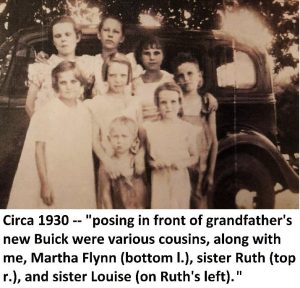 But on the way let’s stop the Wayback machine to watch a baseball game. The year? 1923 – exactly 100 years ago. The place? Cleveland, Ohio’s League Park, aka Dunn Field (demolished in 1951). On Saturday, July 7, the Cleveland Indians beat the Boston Red Sox 27–3; the most runs scored in a game by a major league team without hitting a home run (1901 onwards).
But on the way let’s stop the Wayback machine to watch a baseball game. The year? 1923 – exactly 100 years ago. The place? Cleveland, Ohio’s League Park, aka Dunn Field (demolished in 1951). On Saturday, July 7, the Cleveland Indians beat the Boston Red Sox 27–3; the most runs scored in a game by a major league team without hitting a home run (1901 onwards).
If tennis is your game, let’s fly over London to watch the international tennis championship played at Wimbledon. On this day, Bill Johnston beat fellow American Frank Hunter 6-0, 6-3, 6-1 for his only Wimbledon title.
Baseball, tennis, all good – but not as important as the historical event that occurred in Wadesboro: the birth of our resident, Martha Flynn, who was born on that same day 100 years ago: July 7, 1923. Dubbed “Mimi” by her grandchildren, this venerable lady is a mother of four children and a former homemaker whose age gracefully surpasses the ten-decade mark, and whose journey parallels the history of our nation. As we continued our conversation, her mere presence was a living bridge that connected us to the pages of her past. Her life stories breathed life into the struggles and sacrifices that transformed her dreams into reality.
“My parents,” she said, “were Angus and Leo Scarborough. We lived across the street from my grandmother. Not only did my granddaddy run his own grocery store, he also operated a cotton gin and a fertilizer plant and owned a lot of rental homes. I think he was pretty well-off!
“I grew up in Wadesboro’s schools, finally graduating in 1941. My favorite high school teacher was Mr. Wildermuth because he was so kind and would patiently answer all my questions. After high school I studied “The Principles of Banking” at a local technical school and then took a job at Wadesboro’s Southern National Bank (now BB&T), where I was a bank teller and took care of the vault.”
Most bank robbers don’t even bother with the bank’s vault; according to the FBI, the vast majority of crimes happen at the counter. “Such was the case one day when I was suddenly held at gunpoint by a would-be robber. I didn’t panic, however. I silently pressed the panic button under the counter. The police soon arrived and took the robber off to jail. The thankful bank president later gave me a dozen roses in a special ceremony.
Around this time I attended another ceremony – that of my own wedding. I had gone to my just-married girlfriend’s house for a party, when she introduced me to a man named Bill Coln. To make a long story short, we soon got married and eventually had four children: Jerry, Anne, Susan and Gayle. Today, Jerry lives in Raleigh, Anne lives in Greensboro, Gayle lives in Apex, and Susan lives in Ocean Isle Beach down in Brunswick County. I have seven grandchildren and several great-grandchildren.
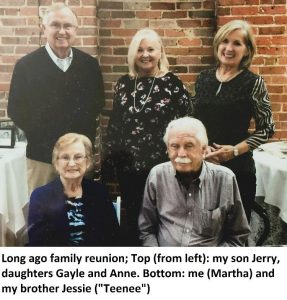 But sadly, after several years Bill and I parted; I later married Ernest Flynn. Regretfully, Ernest became ill and passed away quite some time ago. We had no children.
But sadly, after several years Bill and I parted; I later married Ernest Flynn. Regretfully, Ernest became ill and passed away quite some time ago. We had no children.
I have lived here at Independence Village since my family brought me here 4 or 5 years ago. I still do for myself and consider myself a very happy person. I like to play with my iPad and try to recall my many fond memories: like the fabric shop that my mom had out back; the playhouse that Daddy built for me where I played with my dolls; high school graduation day; and visits to my family’s farm where I could run and play and gather Hickory nuts.
One of the things I remember the most was roller skating. I was really good at it. I would skate everywhere: to my friend’s house, to the store, and most especially to school.
I wish I had gone more to the Brown Creek Baptist Church which my grandfather had started in the town of nearby Polkton. And yes, I am very hopeful of seeing Thanksgiving Day once again. I am very thankful!
Resident Ramblings
Disclaimer: The information contained in this newsletter represents the views and opinions of the original creators of such information and does not necessarily represent the views or opinions of Independence Village nor does it constitute an endorsement by Independence Village or its affiliates of such information.
My Mother – by Frank Howes
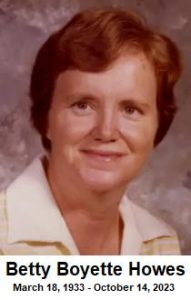 My mother died this past Saturday. I mourn her, but she was ninety years old, and death had been stalking her for months. Old age didn’t creep up on her. It jumped out.
My mother died this past Saturday. I mourn her, but she was ninety years old, and death had been stalking her for months. Old age didn’t creep up on her. It jumped out.
At 89 my mother was vital. She had short-term memory problems, but she could walk without assistance, and she had no other major health problems. But then her ninetieth birthday came last March, and the relatively fast decline came. She dropped from approximately 130 pounds to 95 because she virtually stopped eating. Her memory grew much worse, and you could not have a conversation with her on most days (although there were some days when she was somewhat cogent). When she lost so much weight, she could no longer wear her dentures, and her lips caved in. In other words, she grew old in a period of approximately seven months.
I can describe the kind of caring mother she was by telling you of one habit she had. She made sure everyone in her family had a hearty breakfast – sausage, eggs, and toast – every morning. When I was a junior and senior in high school, I drove a school bus. I had a long route, and I had to leave my house at 5:40 AM. My mother normally got up at about six and cooked breakfast for the family, but during my last two years at home, she got up at 5:00 and cooked breakfast for me every morning. Then she cooked for the rest of the family.
I have missed my mother for years. Since I haven’t driven an automobile for the last eight years, I haven’t seen her as often as I’d like. Of course, now it will be different – impossible.
My father is still alive and pretty healthy. However, I have observed that at ninety, when one spouse passes, the other does too in short order. I hope this is not the case with my father.
I’ll miss you, Mom.
Eleanor of Aquitaine -by Richard Smalto
 Eleanor of Aquitaine, one of Europe’s most beautiful medieval age women, was married to two kings and had three sons who became kings. She was queen consort of both Louis VII of France and Henry II of England. The most powerful woman in 12th century Europe, beautiful, capricious and adored by Louis she exercised considerable influence over him often goading him into undertaking perilous activities. Three of her five sons who became king, Richard the Lionheart and John Lackland wore the crown of England.
Eleanor of Aquitaine, one of Europe’s most beautiful medieval age women, was married to two kings and had three sons who became kings. She was queen consort of both Louis VII of France and Henry II of England. The most powerful woman in 12th century Europe, beautiful, capricious and adored by Louis she exercised considerable influence over him often goading him into undertaking perilous activities. Three of her five sons who became king, Richard the Lionheart and John Lackland wore the crown of England.
She died in 1204. Misjudged by many French historians who noted only her youthful frivolity, ignored her tenacity, political wisdom, and energy that characterized the years of her maturity.
“She was beautiful and just, imposing and modest, humble and elegant;” a queen “who surpassed almost all the queens of the world.” She was a patron of the arts also.
The revolt of her sons against her husband in 1173 put her cultural activities to a brutal end. Since Eleanor, 11 years her husband’s senior, had long resented his infidelities, the revolt may have been instigated by her; in any case, she gave her sons considerable military support. The revolt failed, and Eleanor was captured while seeking refuge in the kingdom of her first husband, Louis VII. Her semi-imprisonment in England ended only with the death of Henry II in 1189. On her release, Eleanor played a greater political role than ever before. She actively prepared for Richard’s Coronation, and administered the realm during his Crusade to the Holy Land. After his capture by the duke of Austria, upon his return from the east, she collected his ransom and went, in person, to escort him to England. During Richard’s absence, she succeeded in keeping his kingdom intact and in thwarting the intrigues against him by his brother John Lackland and Phillip II Augustus, king of France.
In 1199 Richard died without leaving an heir to the throne. John was crowned king. John was not only the offspring of one of Europe’s most glamorous and ubiquitous queens, he was also the favorite son of her resourceful Plantagenet king, better known as Henry the law giver, the founder of the assizes and criminal justice procedure. John was the first king to murder a subject of the crown. A hardworking king and competent military man, he is more often thought to be a villain and is portrayed that way in the tales he begot about Robin Hood, enemy of the Nottingham sheriff and prince of Sherwood Forrest.
A tyrannical king known for greed, avarice and cupidity, rebellious barons, in 1215, fed up with his penchant to tax to raise money, finally forced him to sign the Magna Carta at Runnymede. The foundation of freedom against the arbitrary actions of a despot, it influenced the formation of our own constitution and is considered by British and American legal communities to be the greatest constitutional document of all time.
Ocean Treasures – by Margie Lewin
When Vicky Wall began collecting seashells as a girl, they were just seashells in a small basket.
 Now, though, the 62-year-old Mayodan woman’s shell game has evolved dramatically. She figures she has a couple thousand seashells of every shape and color – all of them meticulously cleaned and cataloged with exotic names like whelks, conchs, hairy tritons and urentlesaps. They range in size the tiny keyhole limpet (about a quarter-inch long) to the left-handed whelk (12 inches).
Now, though, the 62-year-old Mayodan woman’s shell game has evolved dramatically. She figures she has a couple thousand seashells of every shape and color – all of them meticulously cleaned and cataloged with exotic names like whelks, conchs, hairy tritons and urentlesaps. They range in size the tiny keyhole limpet (about a quarter-inch long) to the left-handed whelk (12 inches).
Also among Wall’s favorites is North Carolina’s state seashell, the Scotch Bonnet, a distinction initiated in 1965 by the North Carolina Shell Club, to which she belongs. Wall got serious about collecting in the early 1980s, after her parents bought a condo on Topsail Island, giving her unfettered access to the Carolina coast and its shelling riches. North Topsail, Portsmouth Island, and Shackleford Banks have been especially generous to her, she says; and the best time to hunt are low tide or immediately after a strong Nor’easter. Vicky says “I really enjoy the discovery aspect of it; you never know what you’re going to find walking the beach.”
What Thanksgiving Day Means to Me – by Phyllis Woolley
When I was a child, Thanksgiving did not have the same meaning as it does today. Thanksgiving Day was a day we talked about in school where we were thankful for the Pilgrims, and thankful for four days off from school. We were thankful for the big meal we were going to have. There was also the Thanksgiving Day Parade on TV that we small children sat quietly and didn’t take our eyes away as we watched the floats pass by on the thirteenth-inch Philco TV.
But for me, it was also the day we killed hogs. I hated that! I can still hear the squealing of the pigs as they met their fate and unfortunately the smell of their blood. It was difficult to eat pork for my entire childhood because of that smell and of their blood.
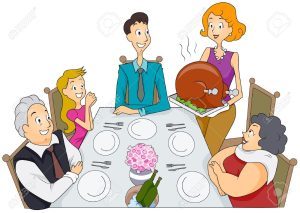 There were eight children in our home and when it came to food, we quickly learned what it meant to be equal to one another. There was one meal served. One option only, and you ate the one option, the same as your sibling, or you didn’t eat. This may sound mean to some, but today my palate is quite diverse.
There were eight children in our home and when it came to food, we quickly learned what it meant to be equal to one another. There was one meal served. One option only, and you ate the one option, the same as your sibling, or you didn’t eat. This may sound mean to some, but today my palate is quite diverse.
Today, Thanksgiving takes on a completely different meaning. It’s a day for family. A traditional meal is served. By traditional, I mean there are generally certain foods served that are traditional according to each family.
As we became adults with children of our own, we were encouraged to develop our own family traditions. Most of my seven siblings had children of our own and had hopefully taught them all year about gratitude and being thankful for everything we had. The food on the table was simply a reminder of past meals we had shared together. We were also reminded of how thankful we were just to be a family. We really didn’t have to share our family memories vocally. Those memories were in our hearts and minds and remain there today. Nobody knows you like you.
As I became a wife and mother, I wanted to keep some of the traditional foods from my childhood as well as my husband’s. Green beans, corn, mashed potatoes and gravy and cranberry sauce were traditional to both my husband David’s and my home. As was a large, beautifully browned turkey. Not just the wings, not just the breast or legs, but the whole turkey sitting regally in the middle of the table, on a large platter in all its glory. There would be ooh’s and aah’s as each person did their own bird inspection. There would always be someone who had to pick off a small piece of the skin to test its crispiness. In my family at home, it would be my brother Sonny. He would be firmly admonished for that and for grabbing a hot yeast roll or corn muffin and quickly stuffing it in his pocket.
Dessert would always include pumpkin pie with a mound of whipped topping. Unknown to many, it is my understanding that a bi-partisan law was passed in Congress where it is a felony to serve naked pumpkin pie. The punishment is up to ten years as the cook in a federal prison. I haven’t actually read the law, but it is quite familiar to my entire family.
Ironically, the one food that was always a part of my family’s Thanksgiving dinner as a child, and David’s family dinner when he was a child, was dumplings, pronounced “dumplins” no matter what Webster says. I studied how my mom made them, and how David’s mom made them, and developed a recipe of my own. I made a dough and would roll it out and cut it in strips. I made a rich chicken/turkey broth in which I would drop the dumplings to cook. As my boys got older, part of our celebration was that they would drop the dumplings. Traditionally it takes two people to finish the dumplings. One to drop, and one to gently stir to keep them from sticking together or to the bottom of the pan.
My fondest memories are of family sitting, not only at the kitchen table, but in the dining room, in the living room on the couch, and yes, even on the floor sharing a meal together. There was so much fun and laughter and yes, good food. It was always loud and I loved it. In my family, the women put leftovers in the refrigerator and the men do the dishes. The primary cook, generally me, was served dinner and was omitted from all after dinner chores.
My hope and prayer for your Thanksgiving is one shared with family and or friends, and a day of pleasant memories and hope for the future. Gratitude my dear friends should be something you share daily.
Why Storks no Longer Deliver Babies – by Pat Simpson
 It used to be that when I looked to the skies not that many years ago, there were literally flocks of storks bringing bundles of joy (aka babies) to their awaiting parents.
It used to be that when I looked to the skies not that many years ago, there were literally flocks of storks bringing bundles of joy (aka babies) to their awaiting parents.
But I thought to myself, this such no longer seems to be the case.
Which begs the question…Why not? Where have all the storks gone? What has happened to all the storks?
So I thought I’d try to find out…
With all due diligence and hours of careful and persistent effort I made it a point to learn for myself. So I visited NC State’s big student library off Hillsborough Street in downtown Raleigh where I learned that the stork story has been around for thousands of years.
In Egyptian mythology, storks are associated with the birth of the world.
In medieval days, some 600 years ago, couples would hold their weddings at annual summer solstice due to believing that summer comes with fertility. Equally, it was the same period when storks used to start their migration journey by flying all the way from Europe to Africa. Coincidentally the storks used to return after nine months during the spring season when babies were born all over Europe. Storks also returned with their newborn chicks, which led to the belief that storks were associated with the idea of delivering new human babies when returning from Africa.
In Eastern Europe, Germany, and the Netherlands, Norse mythology describes how white storks used to nest on the roof of a household, and it was believed they brought good luck by delivering a new baby to the family. Europe was the origin of the myth which also spread to America. Amazingly, the same story is told in Sioux legends with the wood stork.
The story of stork association with babies was equally useful in Victorian England. The story was highly valued as it helped explain the realities of sex as well as the birth of a baby. It was hard for Victorians to disclose the facts of life, but through using the storks’ association with a baby, they were able to reach the point of prudishness.
And the ancient Greeks talk about a revengeful goddess named Hera. As the story goes, Hera was not happy with a beautiful queen named Gerana, and thus she grew jealous of her and transformed the Queen into a stork.
But I still didn’t know why the storks had stopped coming. I had to find out; just count me curious.
At last I found a crippled old stork high atop a rooftop in downtown Raleigh.
I awoke him from his nap. “Excuse me, Mr. Stork,” I said. “My name is Pat. I need to know – Are storks a myth?”
“Young upstart,” he replied. “I was taking a nap. Do I look like a myth? Why don’t you leave an old buzzard like me alone?”
 But I wouldn’t give up – I persisted – until at last I discovered the truth.
But I wouldn’t give up – I persisted – until at last I discovered the truth.
“The truth is,” said Mr. Stork, “if you must know, there was a stork fight in heaven! Unbelievably we storks began fighting amongst ourselves. As a result, the chief stork has banned us from bringing anymore babies – who now have to shift for themselves. As for me, it was a case of self-defense; I’m still recovering from a broken wing.”
“Oh, come on, old-timer,” I said. “What an incredible story! All this stork talk is just a myth.”
“Tell that to the other storks,” he said. “I never knew such pain until I had my eye poked out by Jerome’s pointy beak.”
“This begs the question, Mr. Stork,” I said. “What were you fighting about?”
“We were fighting over just who was going to bring this truly beautiful girl to earth. Who would have the honor of making her soon-to-be-parents exceedingly happy. Unfortunately, it was Jerome who won. Count the rest of us as losers.”
I thought it over. “You may be losers but, given time old-timer, there’ll be another winner.”
After a short and thoughtful pause he replied, “And who is that, might I ask?”
“Her future husband to be. Word is that he would rather spend all day doing nothing with her than all day doing anything with anyone else.”

Ken “Cupcake” Brown Dean Sexton
 The 1st Annual IVOR Writers Club Short Story Contest
The 1st Annual IVOR Writers Club Short Story Contest
The IVOR Writers Club Award competition endeavors to recognize and encourage outstanding writing and foster new insights into culture, society, and the human condition. The goal of our IVOR Writers Club Awards competition seeks to accomplish the same.
The competitions are open to short stories (fiction or non-fiction) in paperback and digital formats.
Let’s get started submitting your short story into the 2023 IVOR Writers Club short fiction Award Competition. Please make submissions to activities director Taylor Clodfelter or to Frank Howes or Pat Simpson of the Writers Club.
Required with each entry:
- Author’s First and last Name
- Author’s Email Address
- Story Title
Winners of our competition will benefit in this way:
A personalized award certificate and a Cash Prize will be awarded to the winning author for a short story.
ELIGIBILITY:
- General Eligibility. Eligible submissions must be a completed short story written in English.
- All submissions must be the work of only one author.
- No entry will be ineligible because its author has previously won an IVOR Writing Award or any other literary award.
- Nominations. Story nominations may be submitted by any interested party but awards and prizes are given only to the author/s of the story submitted.
- Deadlines. Nominated stories are accepted starting November 1, 2023. The final due date is November 21.
- Limits. There is no limit to the number of short stories an author or interested party can submit.
- Eligibility Disputes. In the event of a dispute as to eligibility, the judges will decide whether a story is eligible, and their decision will be final and binding.
